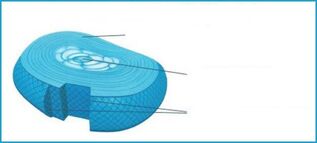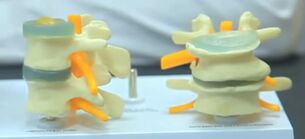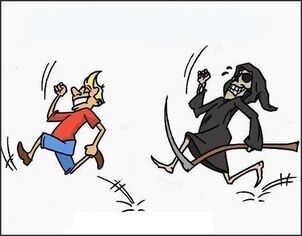Osteochondrosis of the spine - symptoms and treatment, causes, everything has already been said, told. That this is not a disease, but the aging of the body, even if it is stronger than concrete, is also consumed, giving cracks. Unfortunately, this process of destruction, like old age, cannot be avoided, but only slowed down. And most importantly, there are no tablets, mixtures, powders, rejuvenating apples for osteochondrosis. It’s easier to understand, this is compensation, from the fact that we live, walk, make stupid moves, sit, sleep. He cannot perform his functions in full force, as in his youth. By the way, as for young people, why do they have chondrosis? Here is a brief overview of the diseases of the 21st century. Let's define the important functions of the spine. Let's find out the reasons for the main complications in young people and those who are old. We will discuss the diagnosis of the disease and methods of treatment. Let's clarify the basics of prevention and how to save yourself from rapid aging.
Important functions of the spine
We must not forget that our spine has 3 main functions.
- Pivot - keeps the body upright.
- Protective - protects the spinal cord.
- Pads - ligaments, cartilage soften the various movements of our body.

The spine absorbs any load in all areas, thanks to the unique intervertebral discs found in the structure of the spine.
The concept of the word "osteochondrosis"
The term “osteochondrosis” is used only in Russia, in the West they have abandoned this name and instead use the concept of “degenerative disease of the intervertebral disc or cartilage, it can also be called”. This definition reflects the essence of what happens on disks.
Result: if osteochondrosis - degeneration (dystrophy) of intervertebral cartilage from primitive movements. The conclusion from this definition is as follows: dystrophy - a violation of tissue nutrition, and degeneration is a change in the tissue for the worse.
Even understanding the meaning of these words, it is clear what is going on in the spine and where such a popular disease “osteochondrosis” comes from. By the way, what kind of disease is it? Simple - earlier aging.
Degeneration has four stages and stages of development, it develops in all three departments. Osteochondrosis occurs:
- cervical;
- chest;
- lumbar.
Tissue malnutrition
The huge circulatory system nourishes the tissues. Arteries, veins, vessels and capillaries, as well as muscle tissue, are actively involved in the diet. Along with the blood, important nutrients are transferred to the vertebrae, cartilage, and the muscles by contraction help the blood to move at the right speed.
Discs, which do not have blood vessels, absorb water and nutrients at the time of relaxation of the vertebrae. And when you press on them, the same segments, on the contrary, give off the excess. Thus it turns out that during the damping of the spine, due to compression and expansion, the discs are saturated and cleaned by the osmosis method. The more often osmosis occurs, the more satisfied and well fed they are.
The muscles surrounding the vertebrae at the back perform the movement process. It is not difficult to imagine if the muscles around the spine are not too mobile, the blood circulation is slow and the full metabolism is disturbed. Cartilage suffers from a lack of food and cannot be elastic and strong because it develops very spinal dystrophy.
In the early stages of dystrophy, the inclusion of regular sports movement in life can still be corrected fairly quickly. The younger generation has hope for a complete cure.
What's next? For a long time, because they are immobile, the muscles are weak, the ligaments stretch and atrophy to such an extent that they cannot maintain the spine in an anatomical shape, various types of curvature appear:
- lordosis; kyphosis;
- scoliosis.
Discs that do not get the necessary nutrients from the circulatory system for a long time and enough fluid for full existence begin to collapse. That is, there is degeneration, slow modification (destruction). The diagnosis is made - "Osteochondrosis" with all the symptoms and long-term treatment with drugs that are not very effective without exercise therapy.
The fact is that the core of cartilage, which makes up 80% of water, where water gives it elasticity, loses its elasticity with age, and a sedentary lifestyle speeds up this process. As a result, the power of the disk slows down, less water flow becomes thinner in height. But water and useful elements are needed not only for the disk, but also for all the components around it:
- tendons;
- muscles;
- fascia;
- bindings.
But until old age, due to the slow blood circulation, part of the capillaries still dry out, they were not needed for decades, the process of osteochondrosis takes root. At this age, it takes effort to be in shape.
Osteochondrosis is a complex of dystrophic disorders of cartilage and segments. Intervertebral linings are most often affected, but it also develops in the joints, only it has different names - arthrosis, arthritis (as these diseases differ here), coxarthrosis and many other pathologies.
Symptoms and treatment of osteochondrosis of the spine
Reasons
There are external and internal causes of osteochondrosis that lead to damage.
- Internal include genetics, tissue nutritional disorders in youth, old age (this is mentioned above), nervous stress that spasms the muscles and stays in this state for a long time, or maybe forever, making trigger points.
- On external (trauma, low and excessive physical activity).
The obvious reasons for internal and external factors cannot be disputed, except for age. People move to the aging of the musculoskeletal system thanks to their laziness, from the moment they become independent. Realizing the benefits of morning exercise, a healthy lifestyle, at least in part, we consciously use any excuses, excuses to do nothing. I'm not hiding, I was like that myself.
Complications
Dystrophic changes in the intervertebral disc are not a big deal per se. Many live long, do not go to doctors because they are not too worried about the complications of osteochondrosis. But for various reasons, severe pain often occurs. After visiting the doctor, the person after the examination gets a whole bunch of identified complications, such as protrusion, hernia, spondylosis (osteophytes) and spinal instability.
These complications are believed to lead to painful symptoms when there is compression at the nerve endings at the level of the disc of any part of the spine. In addition to pain, weakness, decreased sensitivity, pelvic dysfunction, high blood pressure, and in severe cases, paralysis may occur.
- A protrusion is a slight protrusion of the annular fibrosus outside the boundaries of the vertebral body, due to the enlargement of the nucleus pulposus, sometimes cracks appear in the layers of the annular fiber.
- Herniated disc is the release of annular fibrosus. The cartilage has lost its elasticity and has split into parts, and an excessive load due to this condition causes a bulge, so a hernia appears. It can irritate the nerve root that comes out at the level of the vertebrae from the spinal canal, and then the pain occurs by localization in one or another part of the body.
- Osteophytes - changes in the vertebral bodies themselves, the height of the disc decreases so much that its marginal bone growths (called osteophytes) begin their destructive activity in relation to our health. The size of the hole through which the spinal nerve exits, ie its root, decreases.
There is also a different opinion about the appearance of discomfort and pain, which is why you need to visit a specialist. Soft tissue pathologies (muscles, ligaments, tendons, fascia). Everything that drives our skeleton, and they are the ones that signal, about the initial problems by sending a painful impulse. Diagnoses are made - radiculitis, myositis, myalgia and much more, and all that, allegedly, the symptoms in the background of osteochondrosis of the spine, and treatment is prescribed in the form of painkillers. And then it all repeats itself again, a vicious circle.
In women, reproductive functions begin to die out after the age of 50-55. It is entering the climate phase. It would seem like a natural transition, which you can do here. But if you’re not taking hormone replacement therapy or at least dietary supplements. Osteoporosis then developed rapidly, often confused with osteochondrosis.
Diagnosis of spinal osteochondrosis
Self-diagnosis
- You can determine for yourself whether it is there or not. To do this, it is enough to estimate how often your back hurts. How quickly he gets tired of a little physical work, stress. If there is heaviness, discomfort, sometimes pain, then the changes are already happening inside the spine. Since a healthy person does not feel such symptoms in the back, it is simply healthy. Although there are almost no healthy ones now.
- It is necessary to determine the flexibility of the spine. Flexibility depends entirely on stretching. The better, the healthier the spine.
Diagnostics in the polyclinic
At the doctor's examination, in order to make an accurate diagnosis, an X-ray referral is given. And then the appropriate treatment is prescribed.

Prospects for comparing healthy and diseased segments. The appearance shows how the spinal disc and the body of the segment are the ideal structure created by nature. The nerve endings move freely, are not constricted, the disc is high and has a large safety margin, with such an intervertebral disc a person can withstand up to 800 kg.
And next to it is a model deformed by the disease, the difference is significant. The disc is flattened, the edges of the vertebral body grow and take on a distorted appearance. That's exactly the look in the picture.
Treatment of osteochondrosis
Unfortunately, neglected complications cannot always be cured conservatively, they often need to be treated urgently. But in any case, they are treated and must be treated on time.
Osteochondrosis that occurs at the age of 70 is considered the norm of a person according to age and his doctors do not treat it for years. In young people, there is a different approach, after the diagnosis of symptoms, the necessary treatment is prescribed.
Treatment should be combined only.
- Remove the pain, if any.
- Prescribe physiotherapy, reflexology, massage.
- exercise therapy.
Physiotherapy is basically the basis of treatment, because it helps to restore normal biomechanics of the spine. And that leads to unloading of intervertebral discs. Swimming is a wonderful relief. But the beginning of classes, only after the symptoms of pain subside.
Prevention of osteochondrosis of the spine
Nowadays there are a lot of sedentary occupations of 8 hours and even more, and no organism can withstand that.
The spine is not only the support of our skeleton, but also the housing of the spinal cord. The most important organ for the central nervous system. And if the disease is neglected, you can become disabled. I don’t mean to scare, but limb paralysis is very serious, I know that first hand.
The most important organ for the central nervous system. And if the disease is neglected, you can become disabled. I don’t mean to scare, but limb paralysis is very serious, I know that first hand.
Therefore, in case of spine problems, you should not delay a visit to a specialist, it is more expensive for you. You need to think about a healthy lifestyle more often. Cycling, swimming pool, gym, basic morning exercises and walking. An affordable set of exercises at work that support your body physically and won’t be a wreck in the future.
In order to achieve the result, it is necessary to develop habit, regularity and discipline are the basis of prevention. After all, you don’t need much, the body is grateful, you should love it, pay attention to it and it will respond with good health. And what do you think?
I hope the article is informative for you, you realized that almost everyone has osteochondrosis of the spine, only the symptoms and treatment are different. By studying your body more deeply, you can prevent disease, and by studying from the inside, you will have something to ask your doctor about.
Don't forget to share with friends, subscribe to the update. Be sure to leave a comment.
Take care of yourself and your spine!

























